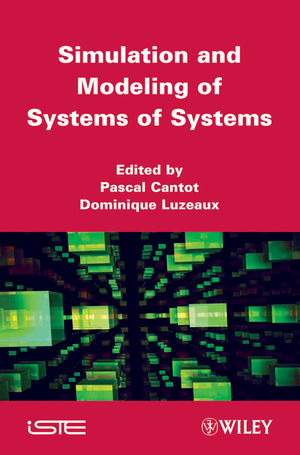
Simulation and Modeling of Systems of Systems
ISTE Ltd and John Wiley & Sons Inc (Verlag)
978-1-84821-234-3 (ISBN)
- Titel z.Zt. nicht lieferbar
- Versandkostenfrei innerhalb Deutschlands
- Auch auf Rechnung
- Verfügbarkeit in der Filiale vor Ort prüfen
- Artikel merken
Systems engineering is the design of a complex interconnection of many elements (a system) to maximize a specific measure of system performance. It consists of two parts: modeling, in which each element of the system and its performance criteria are described; and optimization in which adjustable elements are tailored to allow peak performance. Systems engineering is applied to vast numbers of problems in industry and the military. An example of systems engineering at work is the control of the timing of thousands of city traffic lights to maximize traffic flow. The complex and intricate field of electronics and computers is perfectly suited for systems engineering analysis and in turn, advances in communications and computer technology have made more advanced systems engineering problems solvable. Thus, the two areas fed off of one another. This book is a basic introduction to the use of models and methods in the engineering design of systems. It is aimed at students as well as practicing engineers.
The concept of the "systems of systems" is discussed extensively, after a critical comparison of the different definitions and a range of various practical illustrations. It also provides key answers as to what a system of systems is and how its complexity can be mastered.
Dominique Luzeaux has been employed by the Ministry of Defense for over 20 years. He was Director of the Complex System Engineering Department from 2002 to 2004, and Chief Information Officer from 2005 to 2007. He is currently Deputy Director of the service in charge of the C4ISR (Computerized Command, Control, Communications, Intelligence, Surveillance and Reconnaissance) programs. He has written over 60 articles in international conferences and journals, and teaches robotics, theoretical computer science and system engineering at graduate level.
Introduction xi
Chapter 1. Simulation: History, Concepts, and Examples 1
Pascal CANTOT
1.1. Issues: simulation, a tool for complexity 1
1.2. History of simulation 14
1.3. Real-world examples of simulation 24
1.4. Basic principles 29
1.5. Conclusion 51
1.6. Bibliography 52
Chapter 2. Principles of Modeling 57
Pascal CANTOT
2.1. Introduction to modeling 57
2.2. Typology of models 58
2.3. The modeling process 66
2.4. Simulation project management 91
2.5. Conclusion 94
2.6. Bibliography 94
Chapter 3. Credibility in Modeling and Simulation 99
Roland RABEAU
3.1. Technico-operational studies and simulations 99
3.2. Examples of technico-operational studies based on simulation tools 101
3.3. VV&A for technico-operational simulations 102
3.4. VV&A issues 108
3.5. Conclusions 145
3.6. Bibliography 152
Chapter 4. Modeling Systems and Their Environment 159
Pascal CANTOT
4.1. Introduction159
4.2. Modeling time 160
4.3. Modeling physical laws 163
4.4. Modeling random phenomena 166
4.5. Modeling the natural environment 178
4.6. Modeling human behavior 193
4.7. Bibliography 203
Chapter 5. Modeling and Simulation of Complex Systems: Pitfalls and Limitations of Interpretation 207
Dominique LUZEAUX
5.1. Introduction 207
5.2. Complex systems, models, simulations, and their link with reality 209
5.3. Main characteristics of complex systems simulation 218
5.4. Review of families of models 228
5.5. An example: effect-based and counter-insurgency military operations 244
5.6. Conclusion 246
5.7. Bibliography 249
Chapter 6. Simulation Engines and Simulation Frameworks 253
Pascal CANTOT
6.1. Introduction 253
6.2. Simulation engines 254
6.3. Simulation frameworks 260
6.4. Capitalization of models 290
6.5. Conclusion and perspectives 291
6.6. Bibliography 292
Chapter 7. Distributed Simulation 295
Louis IGARZA
7.1. Introduction 295
7.2. Basic mechanisms of distributed simulation 305
7.3. Main interoperability standards 312
7.4. Methodological aspects: engineering processes for distributed simulation 326
7.5. Conclusion: the state of the art: toward “substantive” interoperability 331
7.6. Bibliography 331
Chapter 8. The Battle Lab Concept 333
Pascal CANTOT
8.1. Introduction 333
8.2. France: Laboratoire Technico-Opérationnel (LTO) 336
8.3. United Kingdom: the Niteworks project 350
8.4. Conclusion and perspectives 351
8.5. Bibliography 352
Chapter 9. Conclusion: What Return on Investment Can We Expect from Simulation? 355
Dominique LUZEAUX
9.1. Returns on simulation for acquisition 355
9.2. Economic analysis of gains from intelligent use of simulations 357
9.3. Multi-project acquisition 367
9.4. An (almost) definitive conclusion: conditions for success 368
9.5. Bibliography 371
Author Biographies 373
List of Authors 375
Index 377
| Verlagsort | London |
|---|---|
| Sprache | englisch |
| Maße | 160 x 236 mm |
| Gewicht | 680 g |
| Themenwelt | Technik ► Elektrotechnik / Energietechnik |
| ISBN-10 | 1-84821-234-8 / 1848212348 |
| ISBN-13 | 978-1-84821-234-3 / 9781848212343 |
| Zustand | Neuware |
| Haben Sie eine Frage zum Produkt? |
aus dem Bereich


